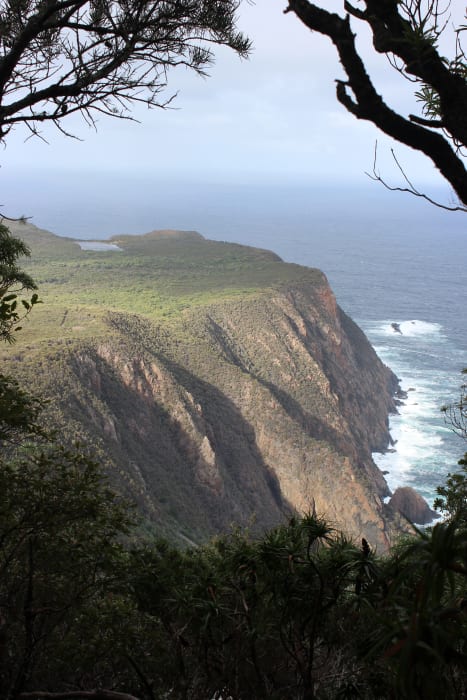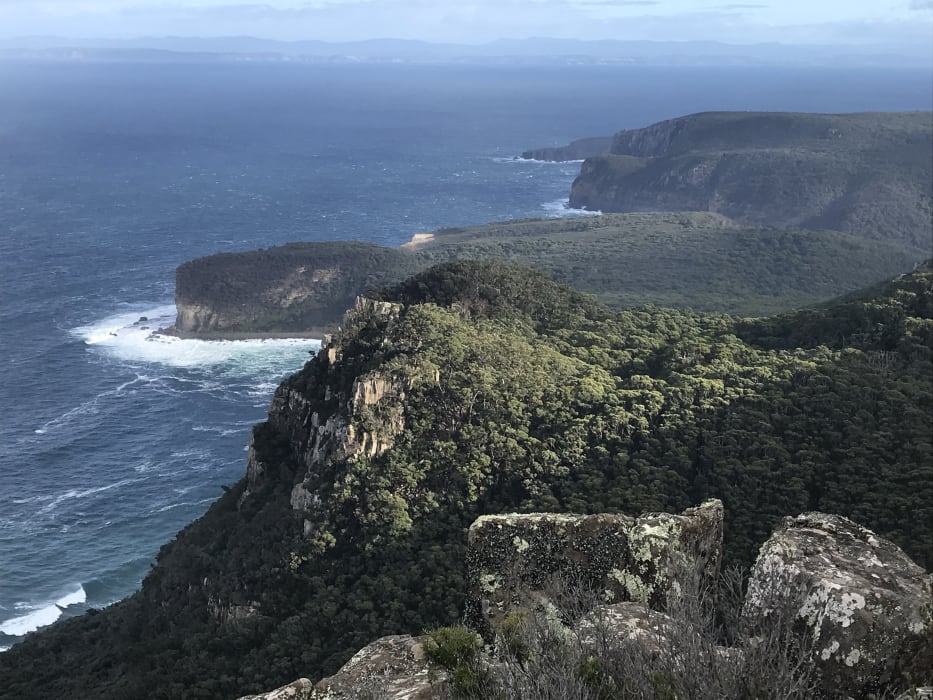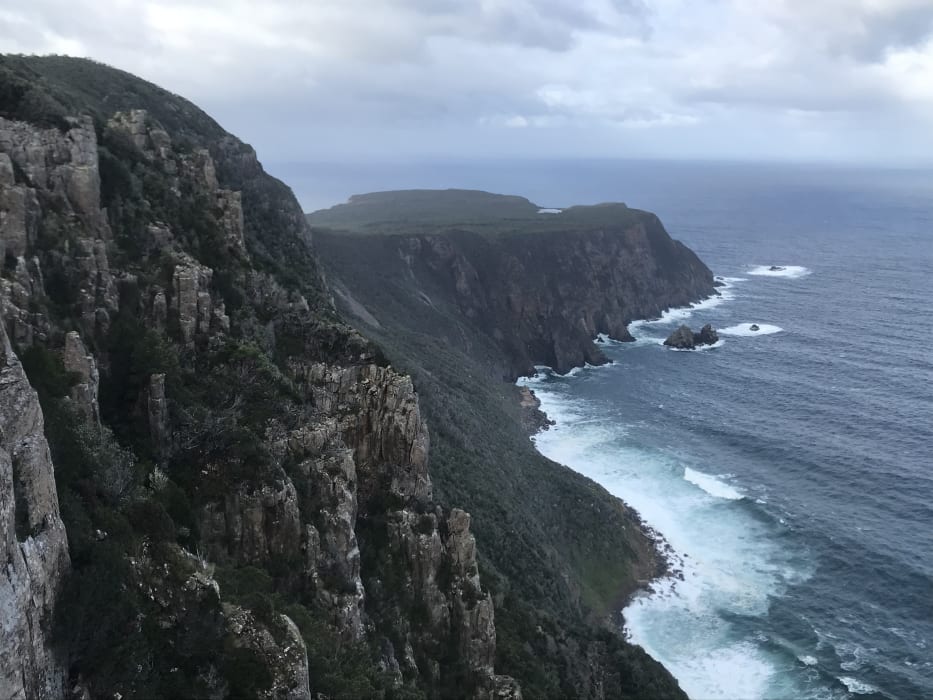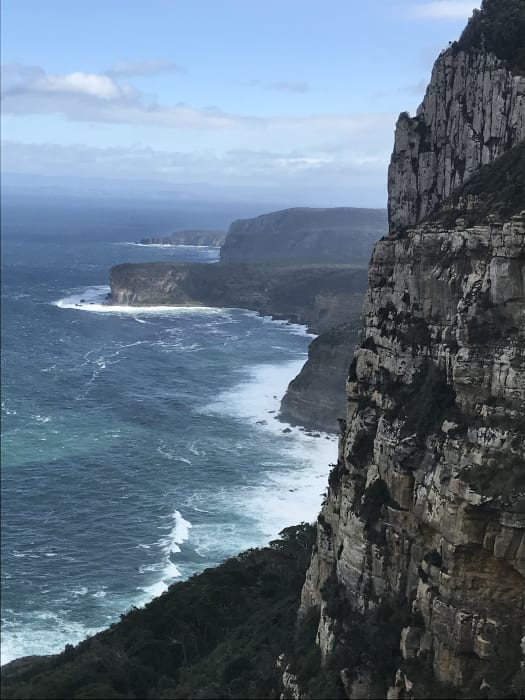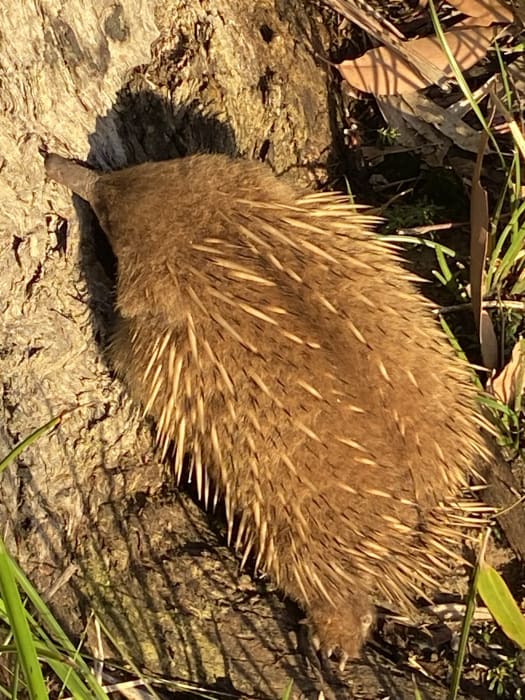writer and photographer DON DEFENDERFER
Which of the three capes is your favourite: Cape Raoul, Cape Pillar or Cape Hauy?
This is a question hikers are often asked and I ask myself too. Which of the three capes on the Tasman Peninsula is the most impressive? I have hiked to all three (and to some of them several times) and I am still in a quandary. They are all so dramatic, scenic and photographically moreish that it is impossible to choose.
What is the most beautiful painting in the world: a Van Gogh, a Picasso or a Monet? What is the finest classical music: Mozart, Bach or Beethoven? Who is the best of the three tenors? What is The Beatles best song? Where are the best camping sites in Tasmania: Freycinet, Cradle Mountain, Maria, Melaleuca or Marrawah?
There is no clear answer to any of these questions, but it is certainly worth investigating when it comes to the Three Capes. So let me give a brief description of each of them and share some photographs and see what you think.
Do not, however, think about it too much, and do not rely on my meditations or images. The best thing to do is to go out to see the capes yourself – put on your hiking boots and have your own experience. Then you too may find out that it is an impossible challenge to choose which is the best, because they are different and individually dramatic. The real question may be whether there is another coastal hike in Tasmania to rival these three for spectacular views.
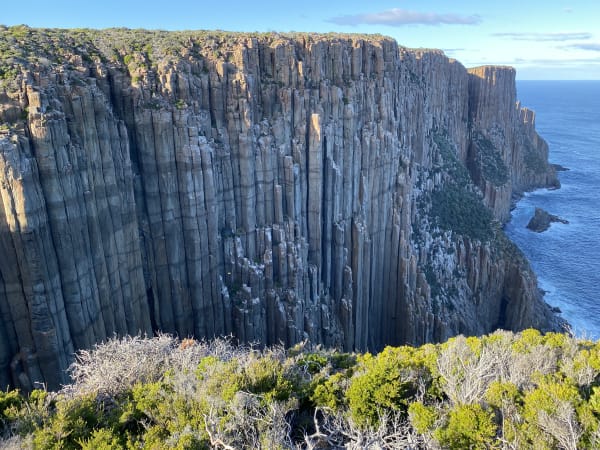
Cape Raoul
The three capes are all part of the Tasman National Park, located in the furthest reaches of the south-eastern tip of Tasmania. Confusingly, the Three Capes Track only visits two capes. You can see Cape Raoul from the main track, but to get there means a detour to the west. It’s a 14km return hike, and it is deceiving. One starts off in the tranquillity of the semi-present (19th century pastoralism), before climbing gently from lush-green farm paddocks and zigzagging more steeply into drier woodlands, along a path past orchids and banksias that welcome one into a bird-trilling stringybark forest.
Within an hour, the gentle dry forests give way to a completely different environment as you come suddenly to an ocean overlook of breathtaking coastal cliffs. The view at the overlook is so dramatic it is startling. One can look straight down 300-metre cliffs to the wild tumult of Tasman Sea and the Southern Ocean, the ocean timelessly beating against a rocky shore; curling white-capped waves and kilometre-long swells, rolling in and smashing against towering cliffs that stand like an ancient fortress, protecting the hidden Eden of Tasmania beyond it.
Stand at the viewpoint and see 10-metre waves sweeping into Shipstern Bluff to your west (renowned for big-wave surfing) and then look to your left and see the curling shape of Cape Raoul’s steep yesteryear-looking dolerite cliffs. If you walk no further, you have experienced the unforgettable views; but walk on to see Cape Raoul up close and personal, a trek that feels like walking backwards in time, into a deep past, into Gondwanaland, along the edge of the dolerite cliffs of the Jurassic.
. . .
The track descends from the viewing spot through a wonderful mix of forest types – remnant ancient rainforests and coastal heaths; sheoaks, banksias and oyster bay pines – and within an hour you find yourself on a volcanic plateau, looking towards the edge of the cliffs of the western edge of Cape Raoul.
Gaze at the near thousand-foot organ-like pipes of the cliffs and marvel at the distant past which lives on in Tasmania. The protruding dolerite polygonal colonnades of Cape Raoul were formed in the Jurassic period, about 180 million years ago, during the break-up of the former supercontinent of Gondwana. Close your eyes, listen to the waves beat the rocks and imagine you are a welcome intruder, a visitor to the past. But open your eyes and find that the past is right in front of you, alive and well in the present.
Walk around to the eastern side of the cape and have lunch on the southern edge of the world. Look across the endless expanse of the sea towards Antarctica, feel the winds whipping against the sturdy cliffs and hear the sound of Australian fur seals heaving and barking below you. Look down and see the seals clinging to an outcrop of wave-beaten, guano-pasted rocks below Cape Raoul. Then gaze to the eastern horizon and see the gallant shape of Cape Pillar protruding in the distance, and your comparison of the Three Capes begins.
Cape Pillar
Getting to Cape Pillar is a bit more difficult than the other capes. It is in the middle of the Three Capes Track, and to get there you must either book and pay for the four-day/three-night hike (and get to Cape Pillar on day three) and stay at the Parks and Wildlife Service’s upmarket, eco-friendly Munro Hut, or you can do the free hike on the original Cape Pillar Track from Fortescue Bay.
The hike from Fortescue Bay is about a 30km return walk, so two days are recommended (or one can return to Fortescue Bay on the main track and journey to Cape Hauy along the way). Campers stay at the new Bare Knoll campsite, near Munro Hut. Staying at Bare Knoll allows one to head to Cape Pillar first thing in the morning, feeling fresh after sleeping among the tall eucalypts near the junction of the peninsula that feeds one down the path to Cape Pillar.
Where the hike to Cape Raoul feels like a journey back into time, the Cape Pillar hike seems more like a welcoming pageant of the present, because the vegetation is so prolific and the bird and local animal life so rich. As you walk you might see an echidna, wombat or a pademelon happily looking up at you with zen-like eyes, or you might spot the sweet and gentle fairy wrens or honeyeaters and hear them singing joyfully amongst the heaths along the track. Here the birds and vegetation and native animals seem to be escorting you down a Wizard of Oz-like track, on a crisp clear sunny Tasmanian morning.
Now, however, the gentle sing-songy path becomes edgy as it skirts along the fenceless edges of near thousand-foot cliffs, with striking views of the sea. Not for the feint-hearted, the path leads one to the knife-edged outcrop of rocks known as The Blade (and above the nearby cliff face cut of The Chasm). The Blade separates those who don’t like views of heights from those that seek them out. The Blade path leads up a twisting staircase right to the edge of the overhanging cliffs for another stupendous view.
From The Blade one can not only gaze across the wild expanse of the ocean and see tall sea stacks just off the coast, but also look down on Tasman Island and see thousands of gulls, gannets and albatross. The view of Tasman Island, its lighthouse and its historic old tramway system, which climbs up its cliffs, is worth the hike itself. The fecundity of wild sea life there is exhilarating.
What a life the old lighthouse keepers would have had on Tasman Island, there on this far-off southern tip of Australia, where the winds and waves and storms of winter would have been exciting and frightening, especially in those isolated times when little of the ocean world south of here was charted or frequented.
Seek out Cape Pillar and The Blade track and the views to the edge of the known world.

Cape Hauy
The most accessible of the Three Capes, the hike from Fortescue Bay to Cape Hauy always seems like a pilgrimage to me – a hike up and down thousands of steps to where Jedi Masters meditate and Gollum, trolls and orcs lurk among the boulders above the cliff edges and towering sea stacks. Over the past 30 years I have done this hike many times and have always felt an elusive spirit at the pinnacle of the hike, perched there on the edge of the cape and looking down at the towers of rocks and rugged coastline.
Like the Cape Pillar track from Munro Bight, the track starts off gently, winding up from the campsites of Fortescue Bay and into coastal vegetation heaven: tall banksias, scented paperbark, yellow dogwoods, dainty blue love keepers, pink flowering boronia, white flag iris, yellow correas, pink heaths and many more – for botanists, it is a paradise of coastal Tasmanian plants.
The 10km round trip to the Cape gets more serious after about an hour when one meets the junction of the Three Capes Walk and Cape Hauy track. Here is where the ups and downs of thousands of steps begins as one commits to head to the end of the track and Yoda’s cliffs above the snarling sea.
Along the way, one walks along a thin path on the edge of the highest sea cliffs in Australia. Here there are striking views looking south, down towards Cape Pillar or straight across to rocky headlands of Cape Hauy. The walk takes one down a long staircase of steps to a plateau and then back up a few more thousand steps, then down to another saddle, before reaching the pinnacle of the hike at the terminus of the headland.
At the end of the track there is a viewing platform where one can look straight down over the towering cliffs and see the dolerite towers of the Candlestick and Totem Poles. The Candlestick is a narrow pinnacle of rock that rises 120 metres from the sea and beckons extreme rock climbers from around the world. One can look them up and down and see wild waves smashing against the sides of these tall thin towers. To climb these totems would be unthinkable – but people do it.
Take a million photos, soak the wildness into your soul. Then walk back slowly, up and down those steps and arrive back at your cosy tent at Fortescue Bay and have a swim in the chilly aqua-green waters, and reflect on the challenge: which of the three Capes is your favourite?
You may have an opinion, you may favour one or the other, but for me, they are all superlative, all amazing, all worth seeing over and over, all worth claiming as the finest coastal hikes in the world.
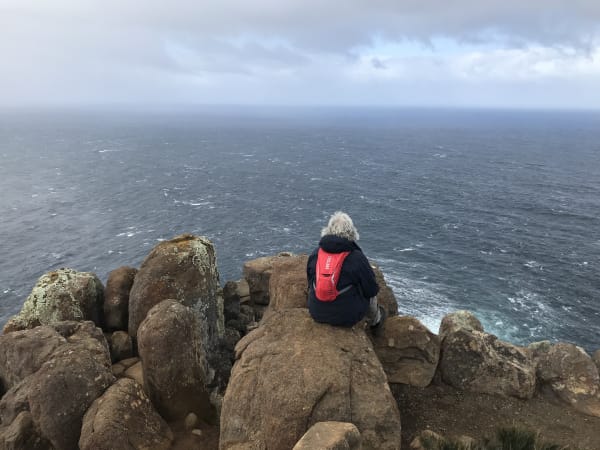
Don Defenderfer is a native of San Francisco who once went on a holiday to Alaska where he met an Australian who told him to visit Tasmania. So he did, and while here he met a woman. That was 40 years ago. He was state coordinator for Landcare for many years, a job that allowed him to be inspired by not only the beauty of the Tasmanian landscape but by the many people that are trying to repair and renew it. He has a Masters Degree in Social Ecology and a Bachelor of Environmental Studies with a minor in writing. He has published three volumes of poetry, and his work has appeared in newspapers and periodicals, including The New York Times and The Australian. Two volumes of collected essays and poems, "Tasmania: An island dream" Parts 1 and 2, can be bought through the Forty South Bookshop.

